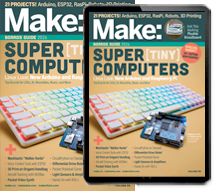x
Make:
Make: Magazine, Volume 23 - PDF
$7.99
/
Shipping calculated at checkout.
Make: magazine, Volume 23 (PDF), the first magazine devoted to digital projects, hardware hacks, and D.I.Y. inspiration.
In this special GADGETS issue, we show you how to make a menagerie of delightful machines: a miniature electronic Whac-a-Mole arcade game, a tiny but mighty see-through audio amplifier, a magic mirror that contains an interactive animated soothsayer, a self-balancing one-wheeled Gyrocar, and the Most Useless Machine the creepy mechanical box whose only purpose is to turn itself off (as seen on The Colbert Report!). Plus: how Intellectual Ventures made their incredible laser targeting mosquito zapper, how to use the industrial-strength microcontrollers called PLCs, and a lot more.
See the "Specifications" tab for the complete table of contents.
In this special GADGETS issue, we show you how to make a menagerie of delightful machines: a miniature electronic Whac-a-Mole arcade game, a tiny but mighty see-through audio amplifier, a magic mirror that contains an interactive animated soothsayer, a self-balancing one-wheeled Gyrocar, and the Most Useless Machine the creepy mechanical box whose only purpose is to turn itself off (as seen on The Colbert Report!). Plus: how Intellectual Ventures made their incredible laser targeting mosquito zapper, how to use the industrial-strength microcontrollers called PLCs, and a lot more.
See the "Specifications" tab for the complete table of contents.


